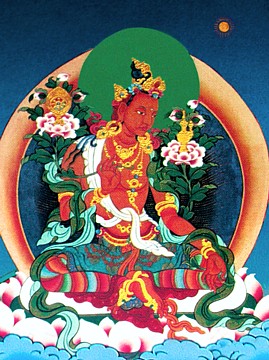「Maitreya 彌勒菩薩 / 彌勒佛」修訂間的差異
跳至導覽
跳至搜尋
SSTC Bubble(對話 | 貢獻) 小 (已匯入 1 筆修訂) |
SSTC foung0316(對話 | 貢獻) 小 (SSTC foung0316 已移動頁面 Maitreya 至 Maitreya 彌勒菩薩) |
(無差異)
| |
於 2016年8月21日 (日) 19:28 的修訂
Maitreya (Skt.; Tib. བྱམས་པ་, Jampa; Wyl. byams pa) or Maitreyanatha (Skt. Maitreynātha; Tib. Jampé Gönpo; Tib. བྱམས་པ་མགོན་པོ་, Wyl. byams pa'i mgon po) is the bodhisattva who will be the next buddha after Shakyamuni Buddha. For now he resides in Tushita. He transmitted teachings to Asanga, who transcribed them as the ‘Five Treatises of Maitreya’. As one of the eight great bodhisattvas, he is sometimes depicted as whitish-yellow in colour and holding an orange bush which dispels the fever of the destructive emotions.
Five Treatises
Maitreya transmitted the root teachings to Asanga. Among the five, four are classed as shastras (commentaries) proper, and one falls into the class of oral instructions. The four that are shastras are extensive are:
| This section contains Tibetan script. Without proper Tibetan rendering support configured, you may see other symbols instead of Tibetan script. |
- The Ornament of Clear Realization (Skt. Abhisamayālaṃkāra; Tib. མངོན་རྟོགས་པའི་རྒྱན་, Wyl. mngon par rtogs pa'i rgyan).
- The Ornament of the Mahayana Sutras (Skt. Māhayānasūtrālaṃkāra; Tib. ཐེག་པ་ཆེན་པོའི་མདོ་སྡེ་རྒྱན་, theg pa chen po'i mdo sde rgyan).
- Distinguishing the Middle from the Extremes (Skt. Madhyāntavibhāga; Tib. དབུས་དང་མཐའ་རྣམ་པར་འབྱེད་པ་, dbus dang mtha' rnam par 'byed pa).
- Distinguishing Dharma and Dharmata (Skt. Dharma-dharmatā-vibhāga; Tib. ཆོས་དང་ཆོས་ཉིད་, chos dang chos nyid rnam par 'byed pa) is very brief and direct in its presentation and is included within the class of oral instructions.
- The Sublime Continuum (Skt. Uttaratantra Śāstra; Tib. རྒྱུད་བླ་མ་, Wyl. rgyud bla ma).
Further Reading
- The Fortunate Aeon: How the Thousand Buddhas Became Enlightened (Berkeley: Dharma Publishing, 1986), volume 2, page 521-523.
- Jamgön Mipham, A Garland of Jewels, (trans. by Lama Yeshe Gyamtso), Woodstock: KTD Publications, 2008
- Sogyal Rinpoche, The Tibetan Book of Living and Dying, pages 125-126.
